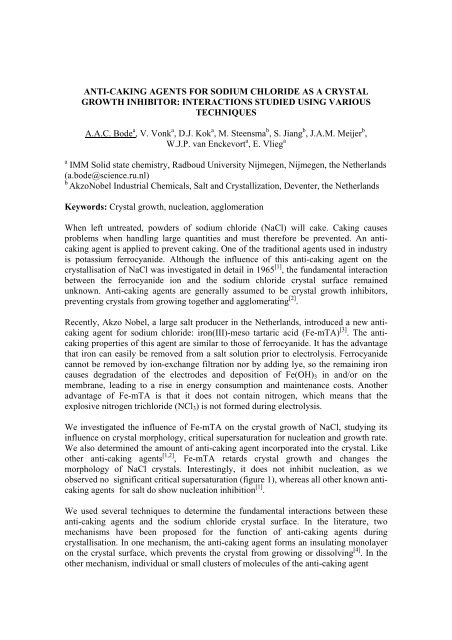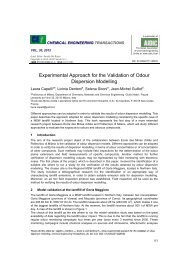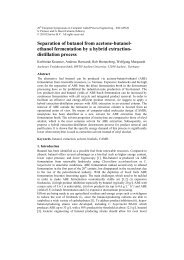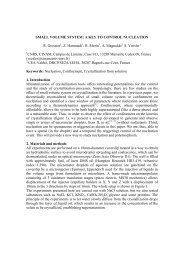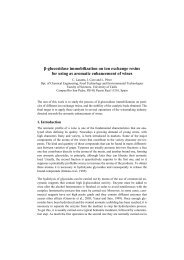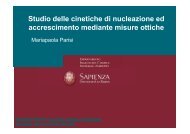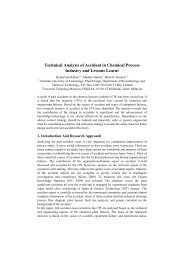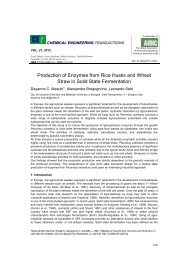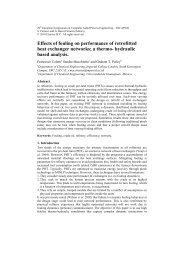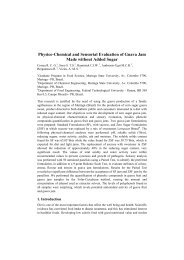ANTI-CAKING AGENTS FOR SODIUM CHLORIDE AS A ... - Aidic
ANTI-CAKING AGENTS FOR SODIUM CHLORIDE AS A ... - Aidic
ANTI-CAKING AGENTS FOR SODIUM CHLORIDE AS A ... - Aidic
Create successful ePaper yourself
Turn your PDF publications into a flip-book with our unique Google optimized e-Paper software.
<strong>ANTI</strong>-<strong>CAKING</strong> <strong>AGENTS</strong> <strong>FOR</strong> <strong>SODIUM</strong> <strong>CHLORIDE</strong> <strong>AS</strong> A CRYSTAL<br />
GROWTH INHIBITOR: INTERACTIONS STUDIED USING VARIOUS<br />
TECHNIQUES<br />
A.A.C. Bode a , V. Vonk a , D.J. Kok a , M. Steensma b , S. Jiang b , J.A.M. Meijer b ,<br />
W.J.P. van Enckevort a , E. Vlieg a<br />
a<br />
IMM Solid state chemistry, Radboud University Nijmegen, Nijmegen, the Netherlands<br />
(a.bode@science.ru.nl)<br />
b<br />
AkzoNobel Industrial Chemicals, Salt and Crystallization, Deventer, the Netherlands<br />
Keywords: Crystal growth, nucleation, agglomeration<br />
When left untreated, powders of sodium chloride (NaCl) will cake. Caking causes<br />
problems when handling large quantities and must therefore be prevented. An anticaking<br />
agent is applied to prevent caking. One of the traditional agents used in industry<br />
is potassium ferrocyanide. Although the influence of this anti-caking agent on the<br />
crystallisation of NaCl was investigated in detail in 1965 [1] , the fundamental interaction<br />
between the ferrocyanide ion and the sodium chloride crystal surface remained<br />
unknown. Anti-caking agents are generally assumed to be crystal growth inhibitors,<br />
preventing crystals from growing together and agglomerating [2] .<br />
Recently, Akzo Nobel, a large salt producer in the Netherlands, introduced a new anticaking<br />
agent for sodium chloride: iron(III)-meso tartaric acid (Fe-mTA) [3] . The anticaking<br />
properties of this agent are similar to those of ferrocyanide. It has the advantage<br />
that iron can easily be removed from a salt solution prior to electrolysis. Ferrocyanide<br />
cannot be removed by ion-exchange filtration nor by adding lye, so the remaining iron<br />
causes degradation of the electrodes and deposition of Fe(OH)3 in and/or on the<br />
membrane, leading to a rise in energy consumption and maintenance costs. Another<br />
advantage of Fe-mTA is that it does not contain nitrogen, which means that the<br />
explosive nitrogen trichloride (NCl3) is not formed during electrolysis.<br />
We investigated the influence of Fe-mTA on the crystal growth of NaCl, studying its<br />
influence on crystal morphology, critical supersaturation for nucleation and growth rate.<br />
We also determined the amount of anti-caking agent incorporated into the crystal. Like<br />
other anti-caking agents [1,2] , Fe-mTA retards crystal growth and changes the<br />
morphology of NaCl crystals. Interestingly, it does not inhibit nucleation, as we<br />
observed no significant critical supersaturation (figure 1), whereas all other known anticaking<br />
agents for salt do show nucleation inhibition [1] .<br />
We used several techniques to determine the fundamental interactions between these<br />
anti-caking agents and the sodium chloride crystal surface. In the literature, two<br />
mechanisms have been proposed for the function of anti-caking agents during<br />
crystallisation. In one mechanism, the anti-caking agent forms an insulating monolayer<br />
on the crystal surface, which prevents the crystal from growing or dissolving [4] . In the<br />
other mechanism, individual or small clusters of molecules of the anti-caking agent
Figure 1. Critical supersaturation for nucleation of NaCl crystals as a function of the initial<br />
concentration of the anti-caking agents (ferrocyanide and Fe-mTA). The boxes show the morphology of<br />
the NaCl-crystals caused by Fe-mTA.<br />
adsorb onto the crystal surface at step edges. The adsorbed molecules slow down step<br />
flow and retard crystal growth [5] .<br />
We studied the influence of the anti-caking agents ferrocyanide and Fe-mTA on the<br />
growth of NaCl crystals by monitoring the step flow of monatomic steps on the {100}faces<br />
of these crystals using atomic force microscopy (AFM). Without anti-caking<br />
agents present, monatomic steps on these crystals are known to become mobile at a<br />
relative humidity of 60% [6] . We confirmed these findings and investigated the influence<br />
of various concentrations of the anti-caking agents on the movement of steps. Figure 2<br />
shows two AFM pictures of step movement on a blank (100) surface.<br />
Figure 2. AFM images of step movement on a blank sodium chloride (100) surface: a) step position at t =<br />
0. b) step position at t = 4 hours. Step movement rate approximately 250 nm/hour.
No step movement is observed when an anti-caking agent is applied. By finding the<br />
minimum amount needed to stop the step movement, we can determine if a full<br />
monolayer of the anti-caking agent is needed or if dispersed single molecules can retard<br />
the step movement.<br />
We used surface X-ray diffraction (SXRD) to determine the chemical interaction<br />
between the ferrocyanide ion and the sodium chloride crystal surface. This technique<br />
can be used to detect atoms adsorbed on a crystal surface. In 2004 this technique was<br />
used to determine the structure of the adsorbed water layer on NaCl [7] . We measured<br />
data sets for a blank (100)-NaCl crystal surface and a (100)-NaCl surface treated with<br />
ferrocyanide. Results show that the ferrocyanide ion, Fe(CN)6 4- , replaces a NaCl6 5-<br />
cluster at the surface. An occupancy of 30% to 50% of a full monolayer was found,<br />
indicating that ferrocyanide does not pin steps. Instead, a (partial) monolayer is needed<br />
to block crystal growth. The ferrocyanide ions have to be removed for growth to<br />
continue. Otherwise, they have to be overgrown, leaving vacancies in the crystal lattice<br />
to counter the charge difference between the cluster and the ferrocyanide ion. This<br />
blocks further growth and explains its anti-caking activity. New experiments are<br />
planned to measure diffraction data of Fe-mTA on the sodium chloride crystal surface.<br />
Finally, we want to determine if the anti-caking agents adsorb preferentially at step or<br />
kink sites on the surface or if they adsorb on the whole surface. To study this, ToF-<br />
SIMS experiments will be performed in imaging mode. This technique can detect iron<br />
atoms with a very high resolution. These measurements are underway.<br />
Combining these different surface science techniques, we acquired a picture of the<br />
fundamental chemical interactions between the anti-caking agents and the crystal<br />
surface. These mechanisms are not yet well understood. However, understanding these<br />
interactions will help to develop anti-caking agents systematically, replacing the trial<br />
and error methods applied up to now.<br />
Acknowledgements:<br />
We thank the Dutch ministry of economic affairs (EOS-KTO programme, Agentschap<br />
NL) for funding.<br />
References:<br />
[1] van Damme-van Weele, M.A. Influence of additives on the growth an dissolution<br />
of sodium chloride crystals, Ph.D thesis: Enschede, the Netherlands, 1965.<br />
[2] Yeong-Lin, C.; Jane-Yu, C. Selection of anti-caking agents through<br />
crystallization. Powder Technology, 1993, 77, 1-6.<br />
[3] Geertman, RM. Use of carbohydrate-based metal complexes in non-caking salt<br />
compositions; US patent WO 00/59828: Arnhem, the Netherlands, 2006<br />
[4] Sangwal, K. Additives and Crystallization Processes, Wiley: New York, 2007<br />
[5] Cabrera, N and Vermilyea, D.A. Growth and Perfection of Crystals, Wiley: New<br />
York, 1958.<br />
[6] Shindo, H.; Ohashi, M.; Baba, K.; Seo, A. AFM observation of monatomic step<br />
movements on NaCl(001) with the help of adsorbed water. Surface Science 1996,<br />
357-358, 111-114.<br />
[7] Arsic, J.; Kaminski, D.M.; Radenovic, N.; Poodt, P.; Graswinckel, W.S.; Cuppen,<br />
H.M.; Vlieg, E. Thickness-dependent ordering of water layers at the NaCl(100)<br />
surface. Journal of Chemical Physics 2004, 120, 9720-9724.


